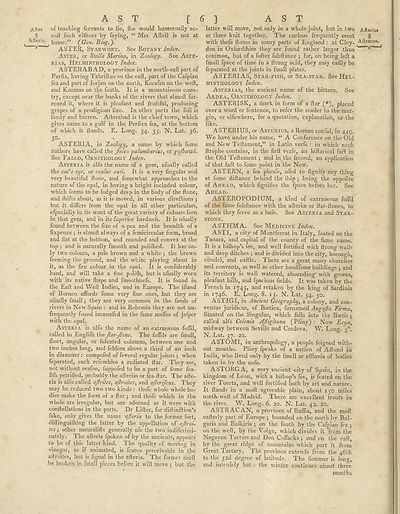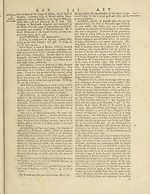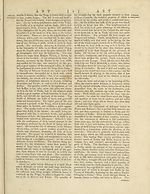Encyclopaedia Britannica, or, a Dictionary of arts, sciences, and miscellaneous literature : enlarged and improved. Illustrated with nearly six hundred engravings > Volume 3, ASS-BOO
(14) Page 6
Download files
Complete book:
Individual page:
Thumbnail gallery: Grid view | List view

AST [
After of teaching fervants to lie, Hie would humoroufly ac-
II coft fuch vifitors by faying, “ Mrs Aftell is not at
Afteriii. home.” (Gen. Biog.).
v ASTER, Starwort. See Botany Index.
Aster, or Stella Marina, in Zoology. See Aste-
rias, Helminthology Index.
ASTERAB AD, a province in the north-eaft part of
Perlia, having Tabriftan on the eaft, part of the Cafpian
fea and part of Jorjan on the north, Korafan on the weft,
and Koumas on the fouth. It is a mountainous coun¬
try, except near the banks of the rivers that almoft fur-
round it, where it is pleafant and fruitful, producing
grapes of a prodigious fize. In other parts the foil is
fandy and barren. Afterabad is the chief town, which
gives name to a gulf in the Perfian fea, at the bottom
of which it Hands. E. Long. 54. 35. N. Lat. 36.
5°. _
ASTERIA, in Zoology, a name by which fome
authors have called the folco palumbarius, or gojhawk.
See Falco, Ornithology Index.
Asteria is alfo the name of a gem, ufually called
the cads eye, or ocu/us cati. It is a very lingular and
very beautiful ftone, and fomewhat approaches to the
nature of the opal, in having a bright included colour,
which feems to be lodged deep in the body of the ftone,
and Ihifts about, as it is moved, in various direftions ;
but it differs from the opal in all other particulars,
efpecially in its want of the great variety of colours feen
in that gem, and in its fuperior hardnefs. It is ufually
found between the lize of a pea and the breadth of a
lixpence ; is almoft always of a femicircular form, broad
and flat at the bottom, and rounded and convex at the
top ; and is naturally fmooth and polilhed. It has on¬
ly two colours, a pale brown and a white j the brown
feeming the ground, and the white playing about in
it, as the fire colour in the opal. It is confiderably
hard, and will take a fine polilh, but is ufually worn
with its native fhape and fmoothnefs. It is found in
the Eaft and Weft Indies, and in Europe. The ifland
of Borneo affords fome very fine ones, but they are
ufually fmall j they are very common in the fands of
rivers in New Spain : and in Bohemia they are not un-
frequently found immerfed in the fame maffes of jafper
with the opal.
Asteria is alfo the name of an extraneous foflil,
called in Englifti the Jlar-Jlone. The foflils are fmall,
fhort, angular, or fulcated columns, between one and
two inches long, and feldom above a third of an inch
in diameter : compofed of feveral regular joints 5 when
feparated, each refembles a radiated ftar. They are,
not without reafon, fuppofed to be a part of fome fea-
fifli petrified, probably the afterias or fea-ftar. The afte-
ria is alfo called ajlrites, ajlroites, and ajlerifcus. They
may be reduced two two kinds : thofe whofe whole bo¬
dies make the form of a ftar j and thofe which in the
whole are irregular, but are adorned as it were with
conftellations in the parts. Dr Lifter, for diftin&ion’s
fake, only gives the name ajleria to the former fort,
diftinguilhing the latter by the appellation of ajlroi¬
tes ; other naturalifts generally ufe the two indifcrimi-
nately. The afteria fpoken of by the ancients, appears
to be of this latter kind. The quality of moving in
vinegar, as if animated, is fcarce perceivable in the
aftroites, but is fignal in the afteria. The former muft
be broken in fmall pieces before it will move j but the
6 ] AST
latter will move, not only in a whole joint, but in two
or three knit together. The curious frequently meet
with thefe ftones in many parts of England : at Cley-
don in Oxfordftiire they are found rather larger than
common, but of a fofter fubftance ; for, on being left a
fmall fpace of time in a ftrong acid, they may eafily be
feparated at the joints in fmall plates.
ASTERIAS, Star-fish, or Sea-star. See Hel¬
minthology Index.
Asterias, the ancient name of the bittern. See
Ardea, Ornithology Index.
ASTERISK, a mark in form of a ftar (*), placed
over a word or fentence, to refer the reader to the mar¬
gin, or elfewhere, for a quotation, explanation, or the
like.
ASTERIUS, or Asturius, a Roman conful, in 449.
We have under his name, “ A Conference on the Old
and New Teftament,” in Latin verfe : in which each
ftrophe contains, in the firft verfe, an hiftorical fact in
the Old Teftament; and in the fecond, an application
of that fa£t to fome point in the New.
ASTERN, a fea phrafe, ufed to fignify any thing
at fome diftance behind the Ihip ; being the oppofite
of Ahead, which fignifies the fpace before her. See
Ahead.
ASTEROPODIUM, a kind of extraneous foflil
of the fame fubftance with the afterioe or ftar-ftones, to
which they ferve as a bafe. See Asteria and Star-
stone.
ASTHMA. See Medicine Index.
ASTI, a city of Montferrat in Italy, feated on the
Tanara, and capital of the county of the fame name.
It is a biftiop’s fee, and well fortified with ftrong walls
and deep ditches ; and is divided into the city, borough,
citadel, and caftle. There are a great many churches
and convents, as well as other handfome buildings ; and
its territory is well watered, abounding with groves,
pleafant hills, and fpacious fields. It was taken by the
French in 1745, and retaken by the king of Sardinia
in 1746. E. Long. 8. 15. N. Lat. 54. 50.
AS FIG I, in Ancient Geography, a colony, and con-
ventus juridicus, of Baetica, furnamed Augiijla Firtna,
fituated on the Singulus, which falls into the Bmtis j
called alfo Colonia AJligitana (Pliny) : Now Ecya,
midway between Seville and Cordova. W. Long. 50.
N. Lat. 37. 20.
ASTOMI, in anthropology, a people feigned with¬
out mouths. Pliny fpeaks of a nation of Aftomi in
India, who lived only by the fmell or effluvia of bodies
taken in by the nofe.
ASTORGA, a very ancient city of Spain, in the
kingdom of Leon, with a biffiop’s fee, is feated on the
river Tuerta, and well fortified both by art and nature.
It ftands in a moft agreeable plain, about 150 miles
north-weft of Madrid. There are excellent trouts in
the river. W. Long. 6. 20. N. Lat. 42. 20.
ASTRACAN, a province of Ruffia, and the moft
eafterly part of Europe 5 bounded on the north bv Bul¬
garia and Bafldria 5 on the fouth by the Cafpian fea j
on the weft, by the Volga, which divides It from the
Nagayan Tartars and Don Coffacks ; and on the eaft,
by the great ridge of mountains which part it from
Great Tartary. The province extends from the 46th
to the 52d degree of latitude. The furamer is long,
and intenfely hot : the winter continues about three
months
Afterias
H
Aftracan.
'
After of teaching fervants to lie, Hie would humoroufly ac-
II coft fuch vifitors by faying, “ Mrs Aftell is not at
Afteriii. home.” (Gen. Biog.).
v ASTER, Starwort. See Botany Index.
Aster, or Stella Marina, in Zoology. See Aste-
rias, Helminthology Index.
ASTERAB AD, a province in the north-eaft part of
Perlia, having Tabriftan on the eaft, part of the Cafpian
fea and part of Jorjan on the north, Korafan on the weft,
and Koumas on the fouth. It is a mountainous coun¬
try, except near the banks of the rivers that almoft fur-
round it, where it is pleafant and fruitful, producing
grapes of a prodigious fize. In other parts the foil is
fandy and barren. Afterabad is the chief town, which
gives name to a gulf in the Perfian fea, at the bottom
of which it Hands. E. Long. 54. 35. N. Lat. 36.
5°. _
ASTERIA, in Zoology, a name by which fome
authors have called the folco palumbarius, or gojhawk.
See Falco, Ornithology Index.
Asteria is alfo the name of a gem, ufually called
the cads eye, or ocu/us cati. It is a very lingular and
very beautiful ftone, and fomewhat approaches to the
nature of the opal, in having a bright included colour,
which feems to be lodged deep in the body of the ftone,
and Ihifts about, as it is moved, in various direftions ;
but it differs from the opal in all other particulars,
efpecially in its want of the great variety of colours feen
in that gem, and in its fuperior hardnefs. It is ufually
found between the lize of a pea and the breadth of a
lixpence ; is almoft always of a femicircular form, broad
and flat at the bottom, and rounded and convex at the
top ; and is naturally fmooth and polilhed. It has on¬
ly two colours, a pale brown and a white j the brown
feeming the ground, and the white playing about in
it, as the fire colour in the opal. It is confiderably
hard, and will take a fine polilh, but is ufually worn
with its native fhape and fmoothnefs. It is found in
the Eaft and Weft Indies, and in Europe. The ifland
of Borneo affords fome very fine ones, but they are
ufually fmall j they are very common in the fands of
rivers in New Spain : and in Bohemia they are not un-
frequently found immerfed in the fame maffes of jafper
with the opal.
Asteria is alfo the name of an extraneous foflil,
called in Englifti the Jlar-Jlone. The foflils are fmall,
fhort, angular, or fulcated columns, between one and
two inches long, and feldom above a third of an inch
in diameter : compofed of feveral regular joints 5 when
feparated, each refembles a radiated ftar. They are,
not without reafon, fuppofed to be a part of fome fea-
fifli petrified, probably the afterias or fea-ftar. The afte-
ria is alfo called ajlrites, ajlroites, and ajlerifcus. They
may be reduced two two kinds : thofe whofe whole bo¬
dies make the form of a ftar j and thofe which in the
whole are irregular, but are adorned as it were with
conftellations in the parts. Dr Lifter, for diftin&ion’s
fake, only gives the name ajleria to the former fort,
diftinguilhing the latter by the appellation of ajlroi¬
tes ; other naturalifts generally ufe the two indifcrimi-
nately. The afteria fpoken of by the ancients, appears
to be of this latter kind. The quality of moving in
vinegar, as if animated, is fcarce perceivable in the
aftroites, but is fignal in the afteria. The former muft
be broken in fmall pieces before it will move j but the
6 ] AST
latter will move, not only in a whole joint, but in two
or three knit together. The curious frequently meet
with thefe ftones in many parts of England : at Cley-
don in Oxfordftiire they are found rather larger than
common, but of a fofter fubftance ; for, on being left a
fmall fpace of time in a ftrong acid, they may eafily be
feparated at the joints in fmall plates.
ASTERIAS, Star-fish, or Sea-star. See Hel¬
minthology Index.
Asterias, the ancient name of the bittern. See
Ardea, Ornithology Index.
ASTERISK, a mark in form of a ftar (*), placed
over a word or fentence, to refer the reader to the mar¬
gin, or elfewhere, for a quotation, explanation, or the
like.
ASTERIUS, or Asturius, a Roman conful, in 449.
We have under his name, “ A Conference on the Old
and New Teftament,” in Latin verfe : in which each
ftrophe contains, in the firft verfe, an hiftorical fact in
the Old Teftament; and in the fecond, an application
of that fa£t to fome point in the New.
ASTERN, a fea phrafe, ufed to fignify any thing
at fome diftance behind the Ihip ; being the oppofite
of Ahead, which fignifies the fpace before her. See
Ahead.
ASTEROPODIUM, a kind of extraneous foflil
of the fame fubftance with the afterioe or ftar-ftones, to
which they ferve as a bafe. See Asteria and Star-
stone.
ASTHMA. See Medicine Index.
ASTI, a city of Montferrat in Italy, feated on the
Tanara, and capital of the county of the fame name.
It is a biftiop’s fee, and well fortified with ftrong walls
and deep ditches ; and is divided into the city, borough,
citadel, and caftle. There are a great many churches
and convents, as well as other handfome buildings ; and
its territory is well watered, abounding with groves,
pleafant hills, and fpacious fields. It was taken by the
French in 1745, and retaken by the king of Sardinia
in 1746. E. Long. 8. 15. N. Lat. 54. 50.
AS FIG I, in Ancient Geography, a colony, and con-
ventus juridicus, of Baetica, furnamed Augiijla Firtna,
fituated on the Singulus, which falls into the Bmtis j
called alfo Colonia AJligitana (Pliny) : Now Ecya,
midway between Seville and Cordova. W. Long. 50.
N. Lat. 37. 20.
ASTOMI, in anthropology, a people feigned with¬
out mouths. Pliny fpeaks of a nation of Aftomi in
India, who lived only by the fmell or effluvia of bodies
taken in by the nofe.
ASTORGA, a very ancient city of Spain, in the
kingdom of Leon, with a biffiop’s fee, is feated on the
river Tuerta, and well fortified both by art and nature.
It ftands in a moft agreeable plain, about 150 miles
north-weft of Madrid. There are excellent trouts in
the river. W. Long. 6. 20. N. Lat. 42. 20.
ASTRACAN, a province of Ruffia, and the moft
eafterly part of Europe 5 bounded on the north bv Bul¬
garia and Bafldria 5 on the fouth by the Cafpian fea j
on the weft, by the Volga, which divides It from the
Nagayan Tartars and Don Coffacks ; and on the eaft,
by the great ridge of mountains which part it from
Great Tartary. The province extends from the 46th
to the 52d degree of latitude. The furamer is long,
and intenfely hot : the winter continues about three
months
Afterias
H
Aftracan.
'
Set display mode to:
![]() Universal Viewer |
Universal Viewer | ![]() Mirador |
Large image | Transcription
Mirador |
Large image | Transcription
Images and transcriptions on this page, including medium image downloads, may be used under the Creative Commons Attribution 4.0 International Licence unless otherwise stated. ![]()
| Permanent URL | https://digital.nls.uk/193166643 |
|---|
| Attribution and copyright: |
|
|---|
| Description | Ten editions of 'Encyclopaedia Britannica', issued from 1768-1903, in 231 volumes. Originally issued in 100 weekly parts (3 volumes) between 1768 and 1771 by publishers: Colin Macfarquhar and Andrew Bell (Edinburgh); editor: William Smellie: engraver: Andrew Bell. Expanded editions in the 19th century featured more volumes and contributions from leading experts in their fields. Managed and published in Edinburgh up to the 9th edition (25 volumes, from 1875-1889); the 10th edition (1902-1903) re-issued the 9th edition, with 11 supplementary volumes. |
|---|---|
| Additional NLS resources: |
|

